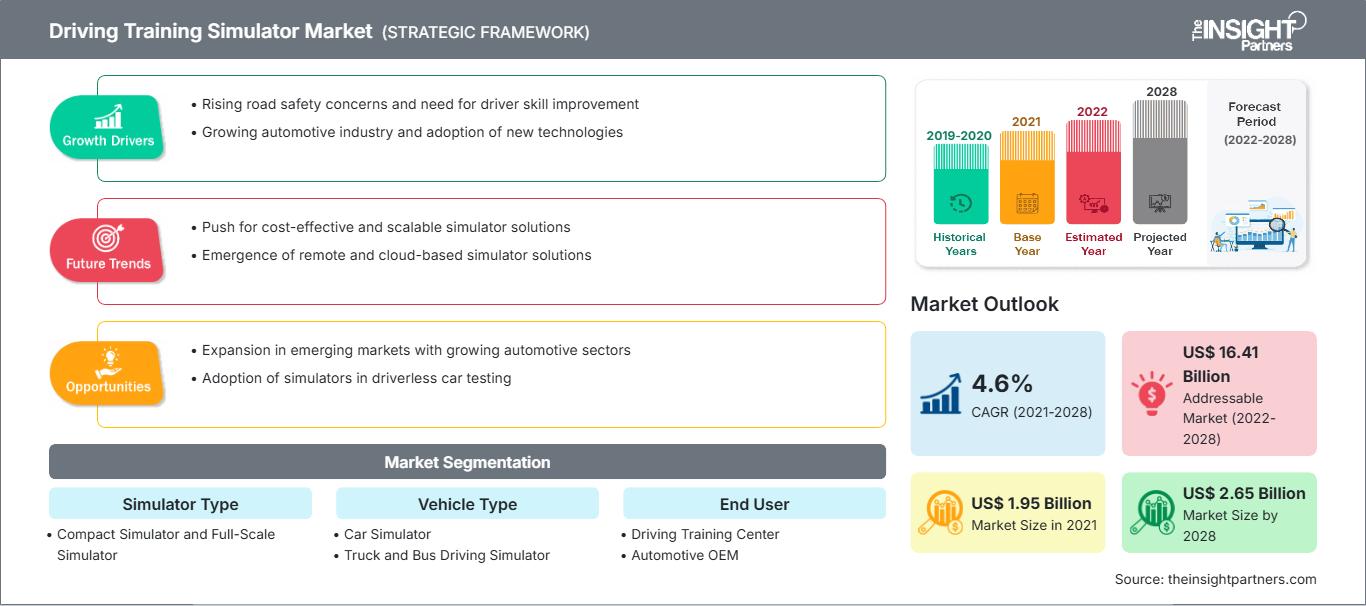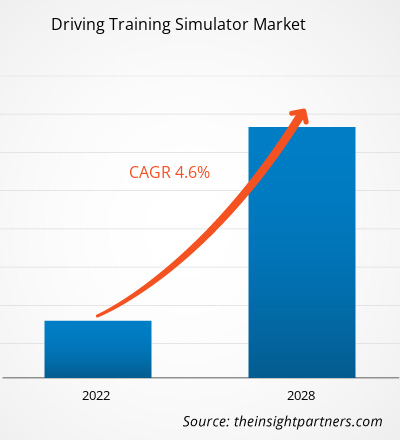The global driving training simulator market was valued US$ 1,950.00 million in 2021; It is estimated to grow at a CAGR of 4.6% from 2022 to 2028
There is a rise in demand for professional drivers due to increased traffic accidents, air traffic, upcoming high-speed train projects, and considerable R&D investments in autonomous cars. This, in turn, fuels the market's growth in developed and developing nations. Expansion of airports and air traffic projects around the globe, simulators for police and emergency vehicles, and the rapid development of autonomous and semiautonomous cars are anticipated to boost the market's growth during the forecast period. However, challenges in real-time control, the lack of norms and standards, and the integration's complexity could hinder the development of the driving training simulator market.
For various stages of vehicle testing, driving training simulators are becoming increasingly popular in the automotive and related industries. Engineers and researchers are currently utilizing this technology to get a realistic impression of a vehicle's overall performance in a virtual environment, assisting in bettering vehicle design and system performance. Flight simulators are also utilized in the military and aviation industries to train pilots to operate both civilian and armed forces aircraft.
Customize This Report To Suit Your Requirement
You will get customization on any report - free of charge - including parts of this report, or country-level analysis, Excel Data pack, as well as avail great offers and discounts for start-ups & universities
Driving Training Simulator Market: Strategic Insights

- Get Top Key Market Trends of this report.This FREE sample will include data analysis, ranging from market trends to estimates and forecasts.
You will get customization on any report - free of charge - including parts of this report, or country-level analysis, Excel Data pack, as well as avail great offers and discounts for start-ups & universities
Driving Training Simulator Market: Strategic Insights

- Get Top Key Market Trends of this report.This FREE sample will include data analysis, ranging from market trends to estimates and forecasts.
Autonomous vehicles must undergo extensive research and testing in various environments to be used on the road. It is difficult to experience the uncommon and hazardous events required for thorough autonomous vehicle validation. These issues are addressed by NVIDIA DRIVe Sim, a physically accurate simulation platform that can produce synthetic data close to real-world situations. With DRIVE Sim, autonomous vehicle (AV) engineers can increase output, efficiency, and test coverage while reducing real-world driving and speeding up time to market. Using high-fidelity and physically accurate simulation, the driving simulator develops a cost-efficient, scalable method of introducing self-driving cars to the road. It uses foundational technologies, such as artificial intelligence (AI), to provide a robust, cloud-based computing platform that can produce a variety of real-world situations for the creation and validation of AV. A driving simulator builds digital twins of actual settings using precision map data and can create datasets to test or train a vehicle's decision-making or perception systems. It can also be connected to the AV stack in software-in-the-loop (SIL) or hardware-in-the-loop (HIL) configurations to verify the entire integrated systems.
The global driving training simulator market is segmented based on simulator type, vehicle type, end user, and geography. Based on simulator type, the global driving training simulator market is segmented into compact simulator and full-scale simulator. In terms of vehicle type, the market is segmented into car simulator, truck and bus driving simulator, and others. Based on end user, the market is categorized into driving training center, automotive OEMs, and others. By geography, the market is segmented into North America, Europe, Asia Pacific, the Middle East & Africa, and South America. North America dominated the overall market in 2021, and Europe accounted for the second-largest share of the market in 2021.
Impact of COVID-19 Pandemic on Driving Training Simulator Market
The COVID-19 pandemic significantly affected North America's automotive OEMs, suppliers, and supply chains. Consumers' reduced willingness to make significant purchases due to uncertain economic crises led to decreased demand for new cars. This simultaneously affected driving training centers in the US and Canada, reducing consumer demand. As a result, the market for driving training simulators for passenger vehicles declined. However, there has been a brief rise in driving simulator demand from 2021. Drivers, who participate in sports events, require simulation training and practice to get a virtual experience of the environment. Further, the rising demand for virtual simulation and safety has enabled automakers to incorporate advanced features such as compact simulators and advanced driver assistance systems (ADAS).
The financial strength of automotive OEMs and suppliers was marginal even before the COVID-19 pandemic. Due to the outbreak, major automotive suppliers witnessed a year-on-year decrease in operating profit. Thus, the North America automotive market declined, resulting in a drop in research & development investments, particularly in the driving simulation industry. In addition, the manufacturing plants of Ford and General Motors slowed their operations due to the safety & lockdown protocols. However, there was a recovery in demand in 2021, due to the ease of lockdowns and financial packages introduced by governments in North America to push economies.
Market Insights – Driving Training Simulator Market
Increasing Need for Skilled Driver and Driving Safety Precautions
Driving response to the rise in accidents brought on by human error, the demand for experienced drivers, who can operate vehicles under various circumstances, is increasing significantly. Since a driving training simulator teaches the driver how to avoid collisions from all angles with the aid of a virtual environment, its demand has also augmented, leading to high market growth. The market is gaining from technological advancements and investments as well.
Around the world, driving safety precautions are becoming more and more critical. Driving simulators are widely used in instructions, testing, and research about safe and responsible driving. Virtual driving simulators can be a safe alternative to on-road testing to conduct research, testing, and training. Researchers have investigated various aspects of research and testing applications, including simulator sickness, weariness, and learned behavior, to improve simulated driving situations for simulator effectiveness.
Collaboration with numerous institutions and technical labs has been an effective strategy for research applications. For instance, train simulators are perfect for teaching new drivers the fundamentals of driving. These portable simulators can successfully deliver instruction through response assessments, perception tests, and vision exams. Trainees learn how to operate trams through virtual reality (VR) and learning experiences provided by tram training simulators. Parameters, such as speed, brakes, and vibrations, are given close attention because supervisors can use these numbers to gauge how well a prospective driver is doing. Thus, the increasing need for skilled drivers and driving safety precautions is aiding the driving training simulator market
Driving Training Simulator Market Regional Insights
The regional trends and factors influencing the Driving Training Simulator Market throughout the forecast period have been thoroughly explained by the analysts at The Insight Partners. This section also discusses Driving Training Simulator Market segments and geography across North America, Europe, Asia Pacific, Middle East and Africa, and South and Central America.
Driving Training Simulator Market Report Scope
| Report Attribute | Details |
|---|---|
| Market size in 2021 | US$ 1.95 Billion |
| Market Size by 2028 | US$ 2.65 Billion |
| Global CAGR (2021 - 2028) | 4.6% |
| Historical Data | 2019-2020 |
| Forecast period | 2022-2028 |
| Segments Covered |
By Simulator Type
|
| Regions and Countries Covered | North America
|
| Market leaders and key company profiles |
|
Driving Training Simulator Market Players Density: Understanding Its Impact on Business Dynamics
The Driving Training Simulator Market is growing rapidly, driven by increasing end-user demand due to factors such as evolving consumer preferences, technological advancements, and greater awareness of the product's benefits. As demand rises, businesses are expanding their offerings, innovating to meet consumer needs, and capitalizing on emerging trends, which further fuels market growth.

- Get the Driving Training Simulator Market top key players overview
Simulator Type-Based Insights
Based on simulator type, the driving training simulator market is segmented into compact simulator and full-scale simulator.
Vehicle Type-Based Insights
Based on vehicle type, the driving training simulator market is segmented into car simulator, truck and bus simulator, and others. Automotive manufacturers, such as BMW, Tesla, Honda, and Toyota, are making significant investments in research & development to deploy autonomous cars to the marketplace and improve the designs or models of the prevailing automobiles.
End User-Based Insights
Based on end user, the global driving training simulator market is segmented into driving training center, automotive OEM, and others. Automotive manufacturers are investing in the development of components, including sensors and processors, that can be utilized in autonomous vehicles.
Players operating in the driving training simulator market are mainly focused on the development of advanced and efficient products.
- In January 2021, Adacel Technologies Limited announced a new five-year contract with Airservices Australia for control tower simulator (CTS) support services. The contract value is estimated at US$ 1 million.
- In February 2021, IPG Automotive GmbH opened a new office in Stuttgart, Germany to offer the customers and partners even broader and more direct support for their projects.
List of Companies:
- Autosim AS
- Bosch Rexroth AG
- Cruden B. V.
- Dallara
- ECA GROUP
- IPG Automotive GmbH
- Moog Inc.
- NVIDIA Corporation
- Tecknotrove
- VI-grade GmbH
Frequently Asked Questions
What is the estimated global market size for the driving training simulator market in 2021?
What are the driving factors impacting the global driving training simulator market?
1. Increasing Need for Skilled Driver and Driving Safety Precautions
2. Simulation for Training Autonomous Vehicle Driving Systems Algorithm
What are the future trends of the driving training simulator market?
Which is the fastest growing regional market?
Which are the key players holding the major market share of driving training simulator market?
Which countries are registering a high growth rate during the forecast period?
What is the incremental growth of the driving training simulator market during the forecast period?
Which is the leading simulator type segment in the driving training simulator market?
What will be the global market size for the driving training simulator market by 2028?
- Historical Analysis (2 Years), Base Year, Forecast (7 Years) with CAGR
- PEST and SWOT Analysis
- Market Size Value / Volume - Global, Regional, Country
- Industry and Competitive Landscape
- Excel Dataset
Recent Reports
Testimonials
Reason to Buy
- Informed Decision-Making
- Understanding Market Dynamics
- Competitive Analysis
- Identifying Emerging Markets
- Customer Insights
- Market Forecasts
- Risk Mitigation
- Boosting Operational Efficiency
- Strategic Planning
- Investment Justification
- Tracking Industry Innovations
- Aligning with Regulatory Trends





















 Get Free Sample For
Get Free Sample For